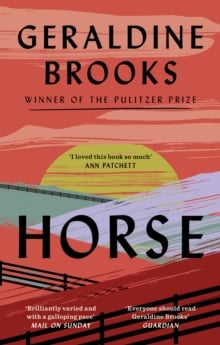
“Horse” by Geraldine Brooks
Geraldine Brooks is one of those American writers that does not seem to have become established on this side of the Atlantic in any comparable way to her US standing, where she won a Pulitzer prize for her novel “March”. This low UK profile is strange as those people who have read her books really enjoy them with some local reading groups having selected some, so here is one for those groups for the future.
“Horse”, Geraldine Brooks’ latest could well attract new readers to her. The horse in question is the famous American racehorse Lexington. It is very much a book about that horse and his groom-cum-trainer – Jarret, who for much of the book is enslaved. Not many racehorses can have become immortalised by having a fictionalised biography written of their lives. Yet this book is so much more than an equestrian story. It offers a very good historical account of the States from 1850 through to 1875 before and during the Civil War. Lexington was painted throughout his career by Thomas J Scott, and we also follow Scott’s life and his art while Lexington is owned by various wealthy landowners. There is a useful bibliophile at the back of the book after the “Afterword” which should not be missed!
There are two other strands to the book both relating to this equestrian art. Martha Jackson, a New York art dealer becomes involved in 1954 with one of Scott’s pictures, but this is very much a side line and sub plot to the main modern day story of Jess, a Smithsonian scientist from Australia and Theo a Nigerian-American art historian-student with a nomadic past. Their meeting is by chance, but Theo has rescued a painting of a racehorse, while Jess has become involved with a British academic who wants to inspect the skeleton of a horse which has been stored away; these are of course both of Lexington. Their stories and how they unfold the history of the painting and of the skeleton provide a whole extra dimension to the book. The movement across the centuries breaks up and enhances the story of Jarret and Lexington and their races and experiences as both are sold and move from Kentucky down to Louisiana and then back.
Jarret and his father Harry are there when Lexington is born on the estate of Dr Warfield, Harry is his trainer and a freeman. They nurture the natural talent of the young foal as he grows into an amazing racehorse. Jarret ‘s whole life is centred on Darley, Lexington’s original name and as his fame spreads and he is acquired by Ten Broeck and is renamed in memory of his origins. Jarret is his constant companion the two build such a bond that they understand each other, the animal following the human’s instructions. Each major race is chronicled and the rivalries between racehorse owners are vividly portrayed. Recurring characters throughout the book are Dr. Warfield’s family and in particular his grand daughter Mary Barr Clay. She grew up alongside Jarret on the estate, they keep in touch after Jarret learns to read and write. Then as near neighbours after Ten Broeck has sold horse and groom to Robert Alexander following a move back to Kentucky and a life at stud.
There is so much in this book. Well researched historical data, the author knows this period well from “March”, but her exploration of the history and origins of racing in America and her detailed knowledge of equestrian physiology are impressive. Some of this detail is again displayed with Jess in the modern section of the book whilst the art history of Theo’s life adds more to the depth and enjoyment of the read. Theo’s dog Clancy is a real character in himself!
A great summer read as it is coming out in paperback in time to be taken on holiday.
